Buying fresh coconuts can be intimidating and frustrating when you choose the wrong one. Let me show you how to choose a coconut that is fresh, and how to open it easily.
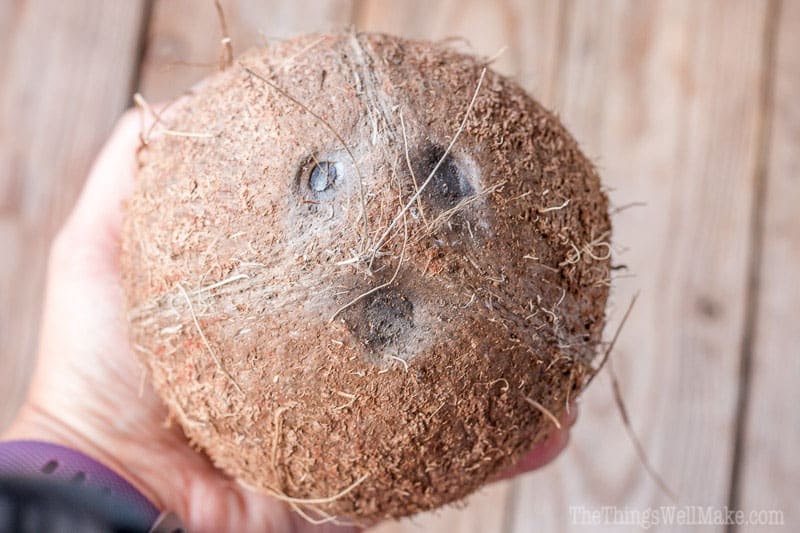
This summer I’ve been on a coconut kick. I’ve been drinking lots of coconut water, making all sorts of drinks and smoothies with coconut milk, and been snacking on homemade coconut chips. I’ve even been using the shell to make some fun crafts! I’ll be telling you about everything I’ve been making soon, but today I’d like to concentrate on how to choose a fresh coconut, and how to open it once you have it home.
To be honest, I stopped buying fresh coconuts for quite some time after buying way too many that were moldy and unusable. When you are paying over a Euro for a coconut, and then you can’t even use it, it’s very frustrating. The coconut water and meat of a bad coconut not only taste sour, but they are probably pretty unhealthy if you choose to continue to eat them anyway.
I got into the habit of buying dried shredded coconut for making coconut milk, coconut flour, and coconut butter, and bought coconut water in cans.
Watch how to open a coconut and make seasoned coconut chips
When I started getting questions about how to make coconut milk, coconut flour, and coconut butter using fresh coconuts from people in Latin American countries where it’s easier and cheaper to buy fresh coconuts than the dried, shredded variety, I decided I should give it a try. I began buying fresh coconuts again, and was just a lot more mindful about choosing them.
Ever since I’ve been pickier in my selection, I haven’t chosen a bad coconut yet! That’s not to say that you won’t occasionally pick a bad one even when looking them over well, but your chances are a lot higher that you’ll choose a fresh coconut.
How to choose a Fresh Coconut
1. Shake the coconut.
When you shake the various coconuts available, you want to choose a coconut that has a lot of coconut water inside. If you find a coconut that doesn’t make a sloshing noise when shaken, do not choose it! Lots of coconut water is a good indication that the coconut is fresher. Those with less coconut water are more likely to have leaks or cracks where the coconut water has escaped, and mold may have gotten inside.
Plus, who doesn’t love having a lot of coconut water to drink?
2. Look at the eyes of the coconut.
I used to just go by the amount of coconut water, but I found that a lot of times coconuts with a lot of water could still have areas that were beginning to mold, and most often than not the main moldy area was near the soft eye of the coconut.
When looking at a coconut, you will notice that it has three eyes.
Not all of the eyes are equal, though. One of the eyes is softer than the others, and because the shell is much thinner in the area of the soft eye, it is often the first place to go bad. (It is also the ideal place to begin opening the coconut- which I’ll get to in a second.)
It may not be super obvious, but there is often a bit of greenish mold around at least one of the eyes of a coconut that is starting to go bad. Usually, when you open one of these coconuts, the water will be slightly sour and taste “off.” You can usually rinse and use most of the coconut in these cases, but you’ll have to discard any parts of the meat that are yellow (or any other color except white) and that don’t taste as they should.
3. Search for cracks, mold, and wet areas.
Apart from the eyes of the coconut, you can also sometimes find other moldy areas. You won’t usually see a full crack on a coconut that is full of water, but you may see small damp areas where a tiny hairline crack has begun to form.
Needless to say, don’t choose any coconuts with visible cracks, mold, or wet areas!
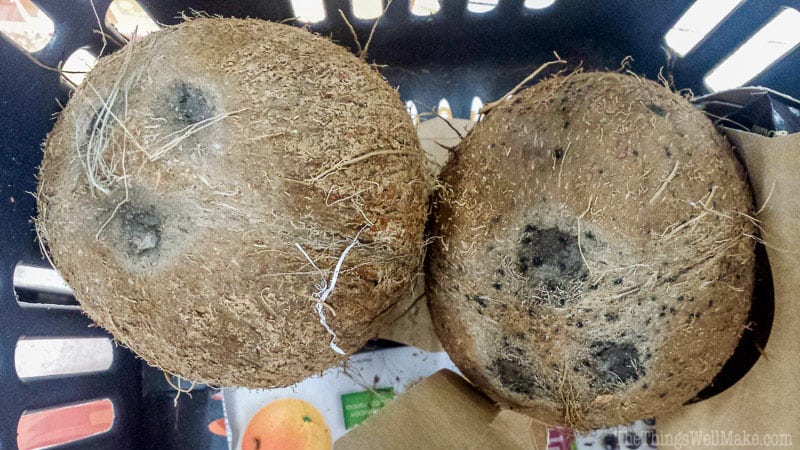
4. When in doubt, choose the heavier coconut for its size.
If you have followed the above tips and are still trying to decide between several coconuts that look pretty good all over, choose the one that is heaviest for its size.
It’s not always easy to tell which coconut is heaviest for its size, but if you are comparing two coconuts that seem the same size, choose the heaviest one. The logic here is that a heavier coconut likely has more coconut water inside and is, therefore, more likely to be freshest of the two.
If you follow those 4 tips, most of the time you should have chosen a good coconut.
If you do end up with a coconut with yellow areas or any other color than white, discard any of those areas. If your coconut only has a small area that seems off, you can taste a small piece from the areas of that are completely white, but if you find that they don’t taste right, discard the entire coconut. It’s always best to be safe than sorry!
Now that you’ve chosen a good coconut, here’s how to open it.

1. Pierce the soft coconut eye.
Look at the eyes of the coconut, and try to find which one is the soft eye. I can usually tell just by looking at the coconut which one will be the soft one because it looks slightly different than the rest. Usually the dark area around the soft eye is a bit bigger than the others, and the soft eye is often rounder and usually is rounded outwards.
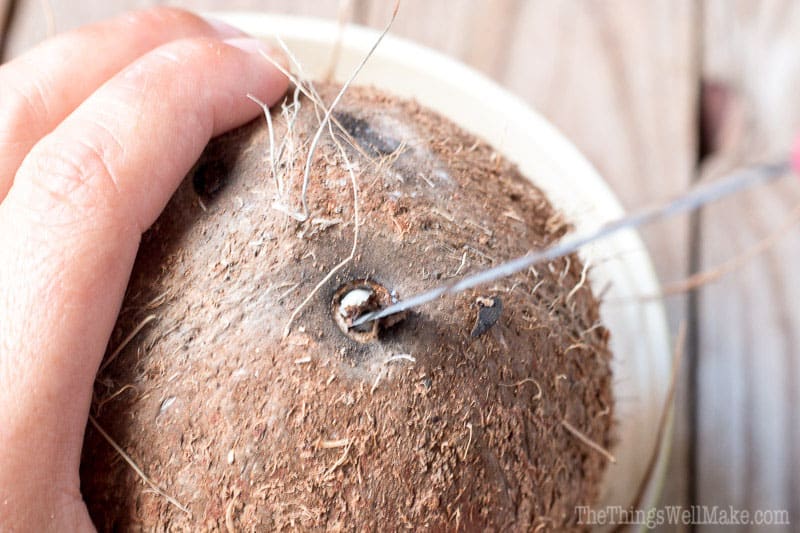
I have a very thin knife which I use to gently make hole in the soft coconut eye by pressing the point of the knife into the eye, and making a turning movement to clear out the coconut meat until reaching the center. If you choose the wrong eye, you’ll find that it’s much too difficult to gently open it with a thin knife. In that case, try with a different eye. There are people that choose to open more than one eye, or all three, but you’ll usually need to open them with a screwdriver and a hammer. I personally, don’t find it necessary.
2. Drain the coconut water from the coconut.
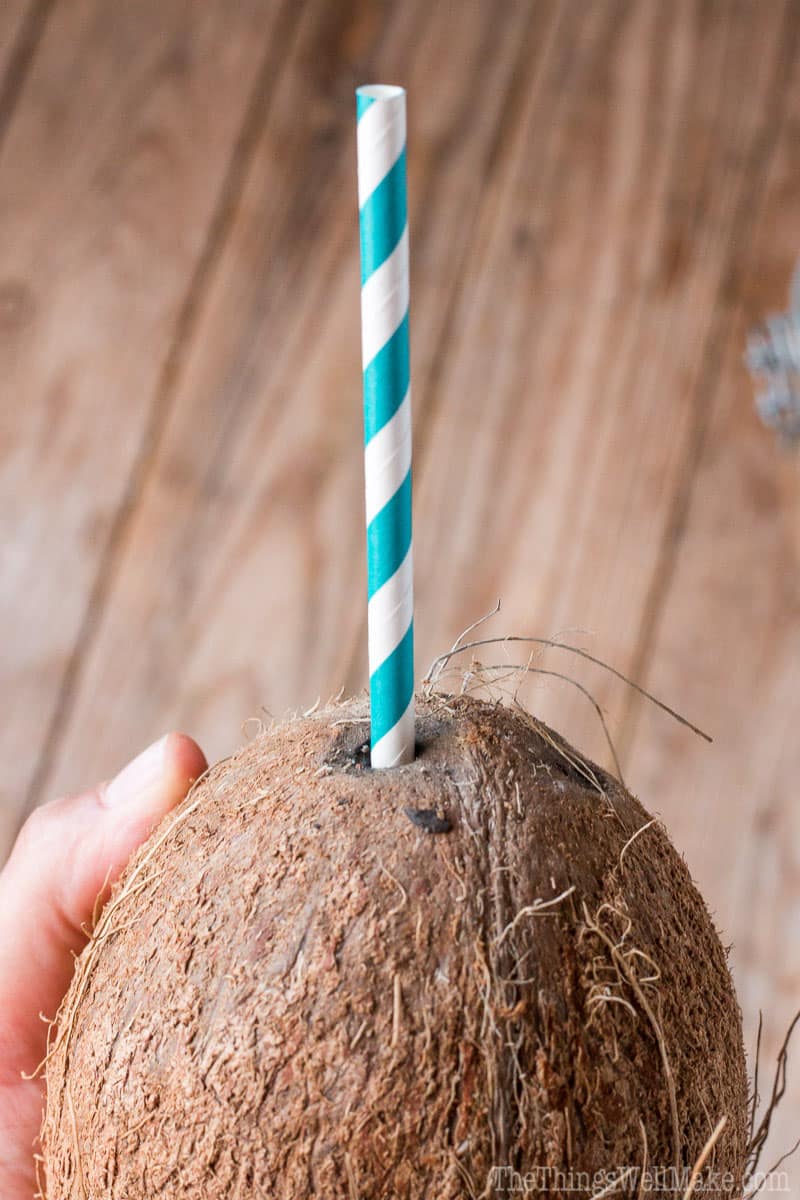
Once you’ve made a hole through the meat of the coconut, you can either stick a straw into the coconut and drink the coconut water out, or flip the coconut over onto and empty glass and let the coconut water drain out. Don’t try to rush it out by pounding it against the glass. I’ve seen people break glasses that way! It will slowly run out on its own, even if you’ve only made one hole.
3. Crack the coconut open.
There are several ways to open a coconut.
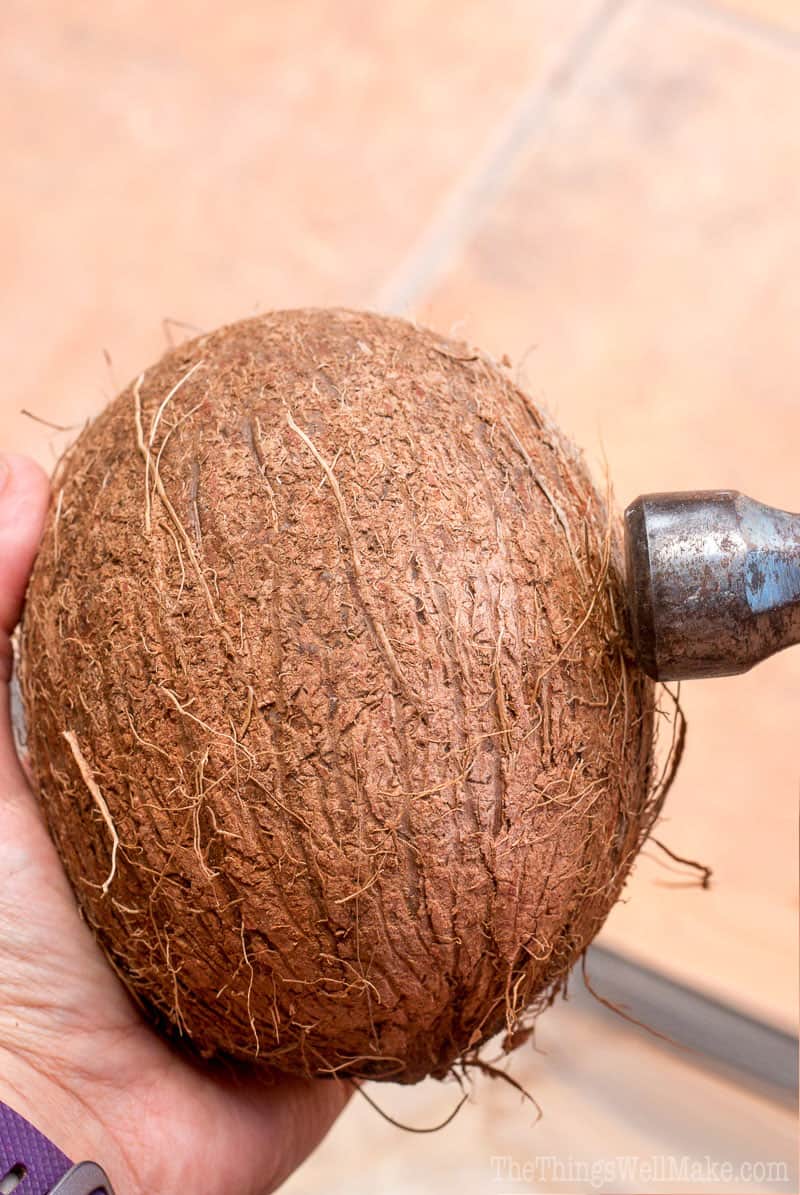
If you have a hammer on hand, I have found the easiest method to open the coconut is to hold the coconut in your hand and hit the center of the coconut with the hammer repeatedly while turning it. By repeatedly hitting it around the center, it will begin to create a fracture line that will get bigger and bigger as you keep going around the coconut. The nice thing about this method is that you don’t need to use a lot of force when you hit the coconut. You just gently hit it repeatedly and eventually it will fracture, usually right around the line of where you continually hit it. (You do need to use a bit of force, though. Hit it hard enough so that it starts bouncing back at you, but not so hard that you hurt your hand!)
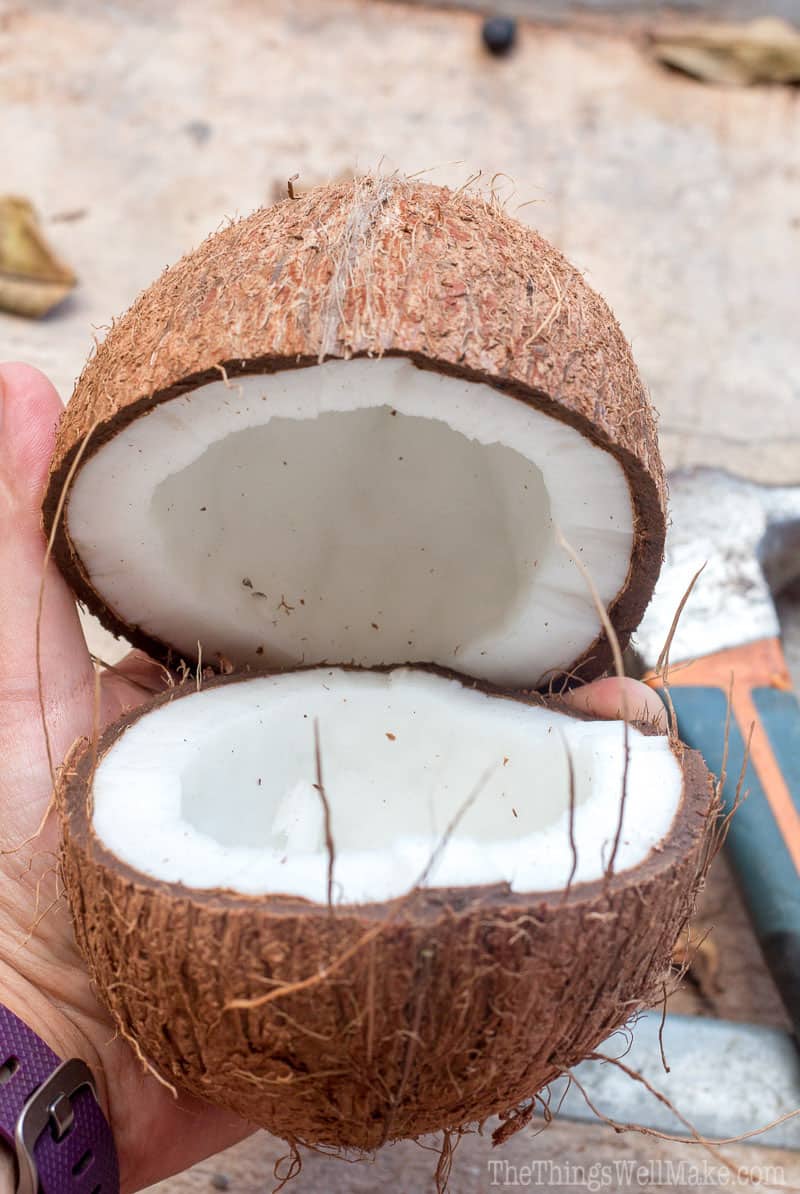
If you don’t have a hammer, you can throw the coconut down onto a cement floor or sidewalk. If you choose this method, you can try placing it in a bag first so that the coconut pieces don’t fly all over the place. You won’t end up with two nice coconut halves with this method, but will instead end up with smaller coconut pieces. More often than not, you’ll end up with small pieces of coconut and some pieces of the coconut meat will have broken apart from the coconut shell, making it easier to eat.
If you want to use the shell for other projects, you can also choose to saw the coconut in half. I’ve done it several times, and it’s not the easiest thing to do, but if you have a bit of patience, you’ll end up with two beautiful coconut halves with a nice cut surface.
3. Pry the coconut meat from the shell.
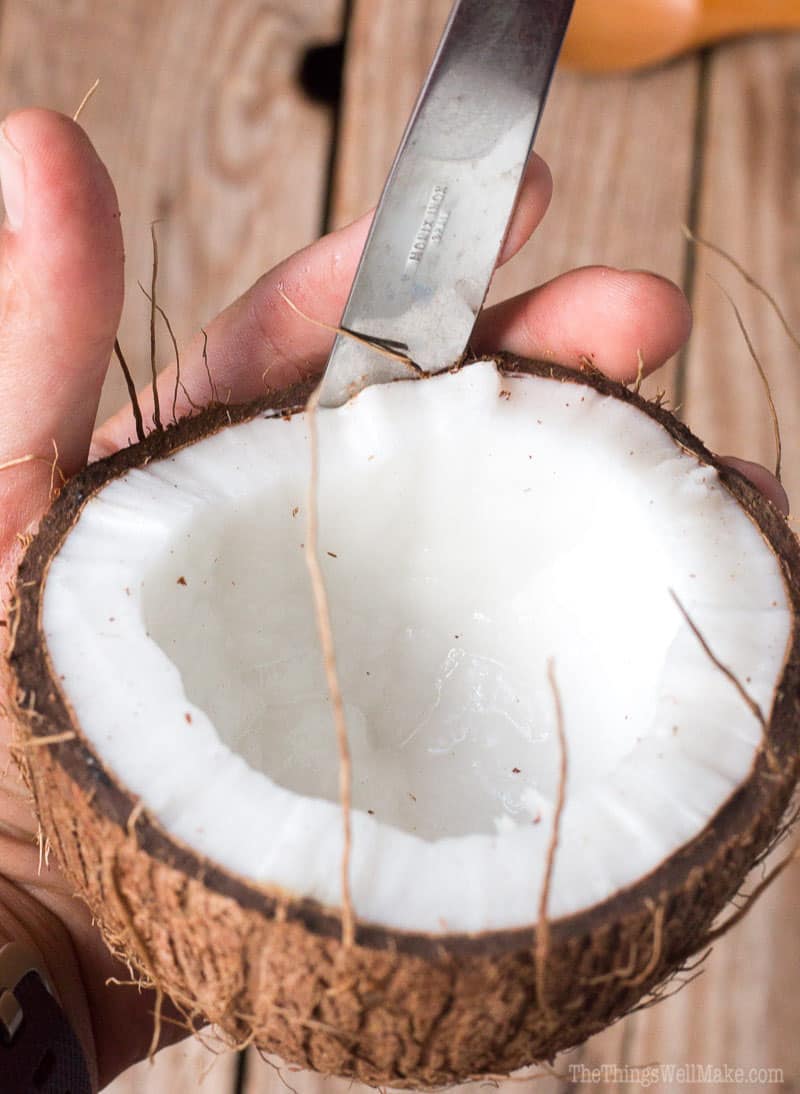
This is probably the hardest part of the process (unless you decided to saw the coconut in half in the last step). I usually use a butter knife and wiggle it in between the coconut meat and the coconut shell. Rather than trying to pry it out in small pieces, I push the knife down as far as I can, and then continue to do the same all the way around the coconut. In many cases with this method I can pry the entire coconut half out of the shell in one piece. Most of the time, though, it comes out in a few big pieces.
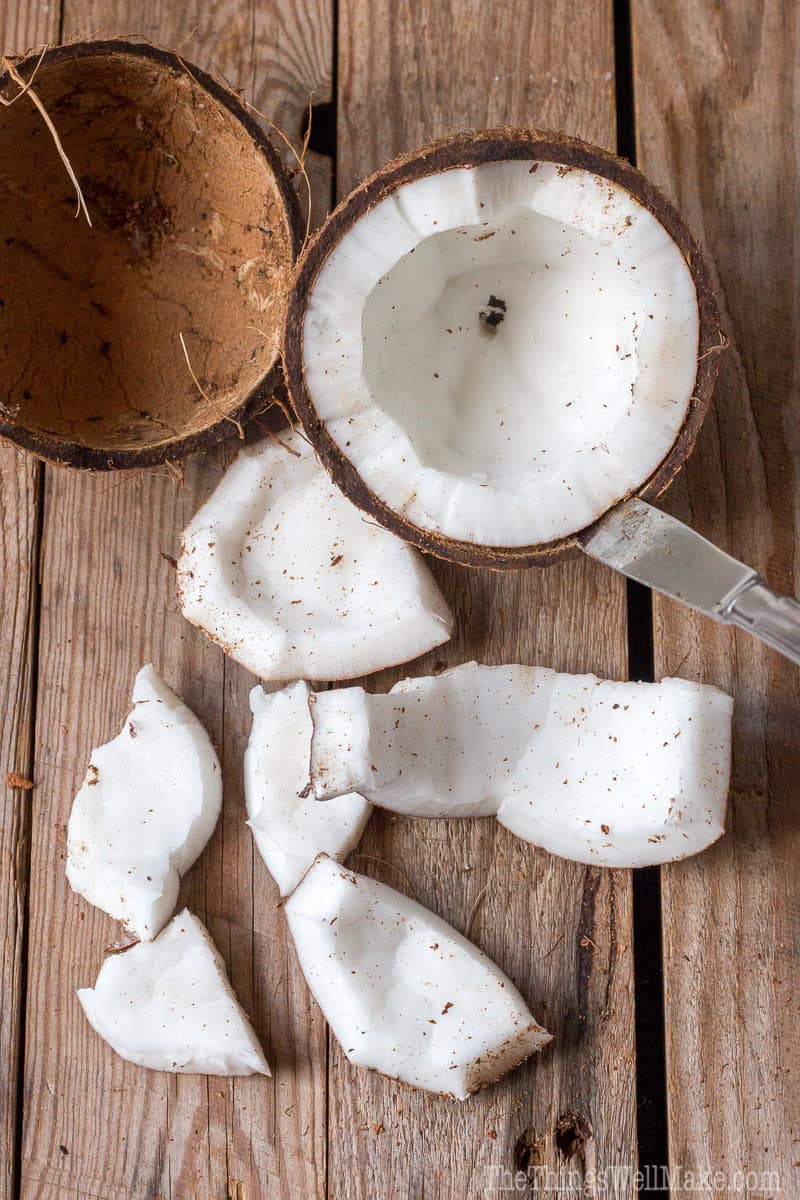
4. You can now eat the coconut meat
From this point, you can either eat the coconut as is, or use a vegetable peeler to peel the brown skin off from the white meat. It is now ready for use in your recipes.
I’ll be sharing several new coconut recipes over the next couple of weeks, and will link to them soon!
Enjoy your coconut!
 Español
Español


 How to Make Boba, aka. Tapioca Pearls, From Scratch
How to Make Boba, aka. Tapioca Pearls, From Scratch
rohit aggarwal
thank you thethingswellmake for giving me wonderful information
Wendy Pham
Hi Tracy,
I’m coconuts supplier so I felt grateful your video “HOW TO CHOOSE A COCONUT AND HOW TO OPEN IT”.
After I saw this video I very happy because I know many people also love coconuts like me. I also saw some people that was comment about quality of coconuts isn’t good when they buy in store so I want to introduce my product with you. I assure it still fresh and good taste when you recieve it.
Thanks & best wishes,
Wendy
Asavina ltd., co
Tracy Ariza
Thanks, Wendy!
Happy to have helped!
Wendy Pham
If I can help you It will be my happy.
You can contact with me everytimes when you need to support by email/
Have you nice day!
Tracy Ariza
Thanks, Wendy. (I removed the contact information to protect your privacy!)
I have your email saved (and hidden) through your comment. 😉
Rachell
This blog was so informational! I am so glad I found it otherwise I would have picked the worst coconut. When I opened it it had the most tasty meat so thanks so much for the tips?
Tracy Ariza
Hi Rachell,
I’m so happy to have been of help! I’m glad you found a great coconut!
Thieu
My favorite trick is to mix the water from young and older coconut, you get the sweetness from the young and strong coconut flavors from the older ones. The easiest way to get meat out of the older coconut is to put it in the microwave on high for 1 minute, the meat will pop right out. I will eat 2-3 coconut a week, depending on what coconuts are available at the open air market.
Tracy Ariza
Hi Thieu,
Thank you for those wonderful tips! I’ll have to give them a try!
It’s unfortunately very difficult (and expensive) to buy green, young coconuts here. It makes me sad because I LOVE them! 🙂
Ruchir Lawate
Hi!
I came across your blog while looking for coconut cookies and since yours are as extra coconutty as I want, I’m going to try them. As you seem to love coconut like me 🙂 , I thought I’d tell you.. another way to ensure a fresh coconut is to check the colour of the husk- lighter the husk, fresher the coconut.. also try soaking the coconut for an hour ar two in water before cracking it- the husk softens and can be scraped off with an old knife. That way, when you do crack it open the flesh doesn’t get contaminated with husk or dirt.. it’s the way we do it here in my part of India where fresh grated coconut is a staple.. also please try googling ‘ coconut grater india’ – you’ll find a host of specific manual and electric coconut grating devices both traditional and modern.. it’s much easier to get snow like soft grated coconut with them, rather than breaking bits of the flesh and cutting it up!
Tracy Ariza
Hi Ruchir,
Thank you so much for your tips!
I’ll definitely look into it and try it out. I may even add some of your tips to my post in my next update! I really appreciate your ideas and love learning new things!
Van
You are crazy! You should check online some videos from South America how to remove the coconut meat from the shell… much easier…
Tracy Ariza
Hi Van,
I find it quite easy to remove, but I’d love to see one of the videos you are speaking of.
The only ones I’ve seen have cut the meat into small pieces, which would make it very difficult to make into coconut chips with a vegetable peeler as I do. Having it all come out in one large piece or several larger pieces makes the peeling it into chips a much easier process. I also save the shells for making soap dishes, toys, and other projects.
If you are aware of an easier process that doesn’t completely destroy the coconut or shell, I’d love to see it. I would update my post with the new findings. For now, I find this very easy.
Jelena
I have to say, you gave some really good advice on picking a good coconut! I was in my local store and saw a good deal on coconuts, googled how to pick a good coconut and quicky scrolled through your instructions. When I came home I foun out it was truly fresh! And the taste, mmm! I do have couple of questions. When I buy coconut, for how long can I store it at home unopened? An for how long can I store pieces of fresh white meat? I really like eating fresh coconut, the crisp is amazing.
As far as buying bad coconuts, I think its a long way from picking them to actually purchasing them in your store. Who knows for how long they travel.. and since its sold without a package, there is really no info when they were picked from the tree.
Tracy Ariza, DDS
Hi Jelena,
I think the storage time really depends on the coconut. You’re right about them traveling for a while before you get them. I’ve left some for several weeks in the fridge and sometimes they’re perfectly fine afterward, and sometimes they are going bad. Of course, it’s impossible to know if they were completely fresh when I bought them to know if it was the storage time that affected them or not.
As for open coconut, I think it only keeps well for a couple of days. It will soon go moldy.
I think I’ve extended the life of the coconut somewhat by storing the pieces in a bowl water in the fridge (completely submerged), but I’m not sure. I usually make half of the coconut into coconut chips. Once dried, it keeps for a really long time.
Deanna
Need to know closest store to buy fresh coconuts . Close to LaCrosse, Wi or Tomsh, Wi
Tracy Ariza
Hopefully someone else can help you. I live in Spain! 🙂
Ashley Donnelly
All your tips worked great for us! The kids loved exploring coconut milk and meat. Yummy! Thanks so much!!
Tracy Ariza
You’re so welcome, Ashley! I’m so glad you and your kids had fun with it!
I saw some kids beg their mom for a coconut while I was buying one at the supermarket this week. She said- “Why would you want THAT!?!?!” and kept moving along. I had a really hard time minding my own business and not going over there and telling her how wonderful they are! 😉
So sad for those kids- how dare they ask for healthy foods! Right? Sigh.
Gary Eldonrek
It’s interesting to see the bad fresh coconut experiences described here, because I too have been experiencing the issue of bad or unusable fresh coconuts for the past two years or so.
During my childhood, I used to help my mother make homemade coconut cakes, and I NEVER remember ever coming across a bad coconut during those years. But now, many years later, of course, when I started to make these cakes, I go through hell to find a usable, tasteful, not spoiled, not sour, not molded coconut.
Once recently, I took my hammer, screwdriver, thick cushion, and container with me to the grocery store, so that I could sit in the parking lot in the car, draining, cracking and testing the coconuts I just purchased. This is a hassle, and I DID have to return two that I bought, and went through six total, before I could actually buy two that were acceptable.
I have tried buying at different stores — Walmart, Fresh Market, Harris Teeter, and even a foreign, specialty food store. Same issues EVERYWHERE — coconuts are rancid under the shell, …. water is sour, … meat is tasteless. It’s frustrating and a waste of time and money — almost NOT worth trying to make these anymore.
I sense that store managers do NOT have a clue about this issue. I live on the East Coast in the USA, and I wonder whether this is a local, regional, or national problem.
Tracy Ariza
Hi Gary,
I feel for you.
I already had issues years ago when I was still living in Michigan and actually stopped buying coconuts because of it. I mostly bought them for the coconut water at the time because I love it, and at the time it was impossible to find bottled up.
Nowadays, I still have issues here in Spain, so, unfortunately, it’s even more than a national issue.
I think that they probably just keep the coconuts until they either sell them all, or who knows what the issue is. Other fruits and veggies are more noticeably bad, so I guess they feel they can just get away with leaving coconuts out almost indefinitely.
They win out with somebody like me who jut sucks it up and accepts the loss. I applaud you for holding them accountable and bringing them back to the store!
sin
Hello Tracy,
Sorry for your tragedy. Even I had a pretty hard time in Frankfurt, searching for good coconut, most of the time ending up wasting money. There is an Indian store in Frankfurt. There also I couldn’t get a good one. But finally my husband got expertise in searching good one. He just taps on the outer shell of the coconut, and from the sound he could make out whether it is good or bad. Consistently he is buying good coconut from Indian store (only) now.
Tracy Ariza
Hi Sin,
Yes, with time, you get better and better identifying the good ones. That is a good tip, but it’s hard to explain to people because it’s not something visual and is something that has to be learned by experience. I imagine that the sound is mostly dependent upon the amount of water left and having a coconut with a good, solid shell. You start to get sort of an intuition about them with time. I find that coconuts with small “eyes” tend to normally be a lot fresher too. Recently I’ve been looking at that as another factor, and should add it to my post. Smaller eyes means less opening for the coconut to dry and for microbes to enter.
Thanks for your comment and tip!
Brian
I used to eat two coconuts per week from 2005 through 2011. Since 2012 I have not been able to find a single coconut at Winn Dixie or Publix that hasn’t been ruined by mold where the inside hard bark has turned to goo. I still buy one every other month or so just to see if the mold issue has been resolved, it hasn’t, I bought a good looking coconut at Publix yesterday 11/14/2017 and it will be going back to the store today again spoiled rotten with mold. What bugs me is that produce managers just don’t seem to care and keep restocking with bad coconuts over and over. I can’t imagine who would eat any of these, they’re disgusting.
Tracy Ariza
Wow, Brian,
That’s really frustrating!
I bought one the other day that I ended up throwing out too. It actually looked pretty good following my guidelines, but did seem a bit lightweight. They all did, though, and I really wanted a coconut so I decided to risk it.
It was the first bad one I’ve bought in awhile- edible, but just not good and not worth it.
I think maybe we need to move to the tropics! 😉